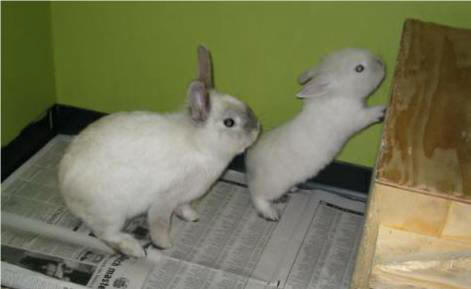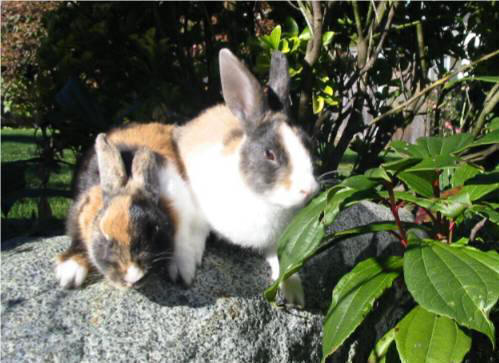Rabbit Facts
- Our domesticated rabbit breeds of today are descendants of the wild rabbits of Western Europe.
- Species: European Rabbit or Oryctolagus cuniculus. The species name means "rabbit who burrows."
Rabbits are mammals which belong to the Lagomorph order that also includes hares and pikas.
There are over 67 recognized breeds in England, 45 in the US, and 30 in Australia, and over 180 world-wide. There are over 60 extinct breeds of rabbits. (2004 figure)
- Rabbits are herbivores.
- Are crepuscular; most active at dawn and dusk.
- They are creatures of habit.
- A male is called a buck and a
female is called a doe.

- Babies are called kittens, kits for short.
- Rabbits are induced ovulators. They have no oustrus cycle.
- Gestation period averages about 30 days.
- Weaning takes place at about 6 weeks.
- Litter size is usually between 4-8 kits.
- Babies are born without fur and blind.
- They open their eyes at about 10 days.
- Females only nurse their young once a day for about 15 minutes.
- Can't retrieve their young like cats and dogs do.
- Rabbits can mate as early as 3 months of age.
- Most breeds are fully mature at
6 months; large breeds at about 8 months.

- Average lifespan is between 5 and 10 years of age.
- They are social and form bonds with each other.
- Rabbits are nearsighted and have a blind spot right in front of them.
- Have a light sensitivity 8 times greater than a human.
- Have 3 pairs of scent glands--under the chin, anal, and inguinal glands.
- Have 28 teeth in total. Upper and lower incissors can grow 1/2"-3/4" per month.
- Have 18 toenails; 4 on each of the hind feet and 5 on each of the front.
- Heart rate is 120 to 300 beats per minute.
- Respiratory rate is 30 to 60 beats per minute.
- Body temperature range from 38.5 to 40.0 degrees Celcius.
- Ears are highly vascularized and help regulate body temperature.
- Cannot vomit and hairballs can be fatal.
- The gastrointestinal system is adapted for the digestion of large quantities of fibrous food. Timothy or grass hay should be fed daily.
- Healthy rabbits that eat a high fibre diet will eat all their caecotrophs, which are a valuable source of nutrients.
- Can go off feed due to an imbalance of organisims in the cecum. The wrong food can kill a rabbit.
- Moulting in adult rabbits follows a seasonal pattern and there are usually two complete coat changes per year.
- The skeleton of a rabbit, especially the backbone, is very fragile and can break easily. Their bones are only 8% of total body weight.
- Spinal disorders are common in pet rabbits.
- Rabbits are inquisitive and intelligent and can learn their names and simple words.
- Because they are prey animals they hide injury or illness well.
- They are ground dwellers and don't like being picked up. Many will struggle and kick violently to avoid being picked up.
- Stress of handling can cause a marked elevation of blood glucose levels.
- They communicate through a variety of ways such as thumping their hind legs, biting, grunting, grinding their teeth, grooming each other, and performing a series of jumps, twists, and runs.
- Burrowing, chewing, and climbing are natural behaviours.
- A rabbit chews 120 times per minute and has 17, 000 tastebuds.
- Rabbits are territorial. Territory can be marked by spraying urine or by depositing faeces.
- They also chin objects to mark what is theirs.
Spaying (ovariohysterectomy) and neutering (orchidectomy) helps prevent health problems, reduces aggression and fighting, and helps control the crisis of overpopulation.
Rabbits commonly suffer from osteoporosis if they don't get enough exercise. A minimum of 4 hours daily is essential to physical and psychological well-being. They cannot lead a healthy life shut in a cage.
If abandoned to the wild, chances are they won't last long. However, enough of these prolific breeders have survived long enough to reproduce and create colonies all over the world.
Information provided by the Rabbit Advocacy Group of BC www.rabbitadvocacy.com
Should I get a pet rabbit for my daughter?
The Province Thu May 28 2015
Page: A43 Section:
Live It!
Byline: Drs. Oz And Roizen
Column: Health Tips Source: The Province
Q: My daughter is 12 and wants to get a pet rabbit. I don't want to discourage
her from learning about animals and having the responsibility of caring for a
pet, but don't rabbits carry diseases?
A: Generally, rabbits are good pets for kids, but all rabbits can carry diseases
such as salmonella (and wild rabbits can carry tularemia or rabbit fever). If
you have a pet rabbit, you want to make sure your daughter doesn't touch the
feces - or, if she does, that she washes her hands immediately afterward. You
also might want to check with your doctor (pediatrician) and possibly an
allergist before picking up Thumper. And make sure you purchase your rabbit from
a reliable source, so it isn't sick when you get it.
Rabbits should be vaccinated against two infectious diseases: myxomatosis (or
myxo) and viral hemorrhagic disease (VHD). Both can be fatal to your rabbit. Pet
rabbits can receive vaccinations at six to eight weeks; booster injections can
be given at six and 12 months.
But, so you know, all pets - from dogs and cats to rodents and birds - can carry
diseases that people can pick up. At last count, we saw there are around 39.
Reptiles and amphibians add a few more. So be careful when handling pets; even a
little cat bite can spell big trouble. Then you and yours will enjoy pet
companionship.
People who keep pets feel less lonely and have lower blood pressure and folks
with dogs get more exercise. We both had pets as youngsters and so did our kids.
Rabbits not vaccinated here
Monday, June 1, 2015 The Province
I would like to correct the misinformation in the Dr. Oz column regarding rabbit vaccines.
While domestic rabbits are vaccinated in Australia, and to a lesser degree, in the United Kingdom, they are not vaccinated in North America. Just ask local veterinarians and others directly involved in the rabbit rescue and advocacy network.
Please do your due diligence and ensure that your material is accurate and applicable to our region.
- Carmina Gooch, Rabbit Advocacy Group ********
Rabbit Haemorrhagic Disease (RHD) also known as rabbit calicivirus disease (RCD) or viral haemorrhagic disease (VHD) only affects European (domestic) rabbits. The virus attacks the cells of blood vessels and causes hemorrhages, and causes some pretty severe death of cells in organs like the liver and the kidneys. So it basically attacks everything at the same time, causes hemorrhages, and the animal dies very quickly. https://rabbit.org/care/vhd.html
NB: The RHD virus is passed in large amounts in the droppings of infected rabbits and can also be spread by contact with rabbit products, rodents, and contaminated objects. It is very hardy, easily withstanding heat and cold. The use of RHD as a biological control agent has been used in Australia and New Zealand in efforts to reduce populations of European rabbits. Not only is this dangerous, it is inhumane, unethical, and largely ineffective.
British Rabbit Council: RHD-2 Facts Sheet
BC SPCA Rabbit Hemorrhagic Disease Information Sheet for Shelters, Rescues & Sanctuaries
Vaccine for rabbit haemorrhagic disease available from B.C. vets